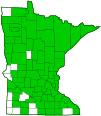creeping bellflower
(Campanula rapunculoides)
Conservation • Weed • Description • Habitat • Ecology • Use • Distribution • Taxonomy
Description |
Creeping bellflower is an exotic, extremely invasive weed. It is native to Europe and western Siberia. It was imported into North America and widely cultivated as a garden ornamental. It readily escapes cultivation. It now occurs throughout northern United States and southern Canada. It is common and widespread in Minnesota. Creeping bellflower is a 16″ to 40″ tall, erect, perennial forb that rises from a long, creeping rhizome. The stems are erect, slender, and usually unbranched. They are usually hairless, sometimes sparsely hairy above the middle. When broken, the stem exudes a milky sap. Basal leaves are, broadly egg-shaped to heart-shaped, ¾″ to 2¾″ long, and 1″ to 1⅜″ wide. They are on 1 9 ⁄16″ to 4″ long leaf stalks. They are rounded or heart-shaped at the base and tapered or angled to a sharp point at the tip. The upper surface is dark green. The lower surface is light green and sparsely hairy. The margins are coarsely toothed with uneven, sharp, forward-pointing teeth. Lower stem leaves are alternate, egg-shaped to triangular egg-shaped, ¾″ to 2″ long, and otherwise similar to basal leaves. The leaves become progressively narrower and on shorter leaf stalks as they ascend the stem. Upper stem leaves are narrowly lance-shaped and nearly stalkless. The inflorescence is a relatively dense, unbranched, up to 12″ long, spike-like array (raceme) at the end of the stem. The flowers are mostly along one side of the central axis. They nod downward on short stalks rising from the axils of bracts, one flower per axil. Lower bracts are the size and shape of the upper leaves. As they ascend the raceme they quickly become much shorter, narrower, and less leaf-like. The flowers are bell-shaped and ¾″ to 1 3 ⁄16″ long. There are 5 green, hairy sepals (calyx), fused at their base into a ⅛″ to 3 ⁄16″ long tube, then separated into 5 lance-shaped, 3 ⁄16″ to ¼″ long lobes. The calyx lobes are widely spreading or bent backward at maturity. There are 5 bluish-violet petals, fused at their base for about half of their length into a ⅜″ to ½″ long tube, then separated into 5 lance-shaped, ¼″ to ⅜″ long lobes. The lobes of the corolla may be ascending, spreading, or bent backward. The calyx and corolla are each radially symmetrical so that if bisected vertically on any plane each half would be identical. There are 5 stamens that do not protrude from the corolla tube. There is a single white or pale style that ends in a stigma with 3 spreading lobes. The style protrudes from the corolla tube but is not as long as the petals. The fruit is a nearly spherical, 3-chambered capsule containing many seeds. The capsule is 3 ⁄16″ to 5 ⁄16″ long, 3 ⁄16″ to ¼″ wide, and is covered with downward curved, bristly hairs. |
Height |
16″ to 40″ |
Flower Color |
bluish-violet |
Similar Species |
Intermediate bellflower (Campanula intercedens) is a much less robust plant. It has linear leaves usually less than ⅜″ wide. The inflorescence is an open cluster of 3 to 8 flowers. |
Habitat |
Lawns, roadsides, disturbed areas. |
Ecology |
Flowering |
June to October |
Pests and Diseases |
|
Use |
|
Distribution |
||
|
Sources |
|
| 6/27/2024 | ||
Nativity |
||
Native to Europe and western Siberia. Introduced, cultivated, and naturalized in North America. |
||
Occurrence |
||
Common and widespread |
||
Taxonomy |
|
Kingdom |
|
Division |
Tracheophyta (Vascular Plants) |
Subdivision |
Spermatophytina (Seed Plants) |
Class |
|
Order |
Asterales (Sunflowers, Bellflowers, Fanflowers, and Allies) |
Family |
Campanulaceae (bellflower) |
Subfamily |
Campanuloideae (bellflower) |
Genus |
Campanula (bellflowers) |
Subordinate Taxa |
|
creeping bellflower (Campanula rapunculoides ssp. cordifolia) creeping bellflower (Campanula rapunculoides ssp. rapunculoides) |
|
Synonyms |
|
Campanula rapunculoides var. ucranica |
|
Common Names |
|
bellflower clochettes creeping bellflower European bellflower Lygurian bellflower purple bell rampion bellflower rapion bellflower rover bellflower roving bellflower |
|
Glossary
Axil
The upper angle where a branch, stem, leaf stalk, or vein diverges.
Bract
Modified leaf at the base of a flower stalk, flower cluster, or inflorescence.
Calyx
The group of outer floral leaves (sepals) below the petals, occasionally forming a tube.
Corolla
A collective name for all of the petals of a flower.
Linear
Long, straight, and narrow, with more or less parallel sides, like a blade of grass.
Raceme
An unbranched, elongated inflorescence with stalked flowers. The flowers mature from the bottom up.
Rhizome
A horizontal, usually underground stem. It serves as a reproductive structure, producing roots below and shoots above at the nodes.
Stamen
The male reproductive organ of a flower consisting of an pollen-producing anther on a supporting filament.
Stigma
The portion of the female part of the flower that is receptive to pollen.
Style
On plants: Part of the pistil, usually a slender stalk, connecting the ovary to the stigma(s). On flies (Diptera): A terminal, often slender or pointed, appendage arising from the end of the last, usually third, antennal segment.
Visitor Photos |
||
Share your photo of this plant. |
||
This button not working for you? |
||
Alfredo Colon |
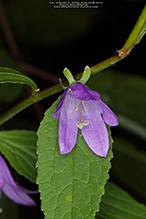 |
MinnesotaSeasons.com Photos |
||
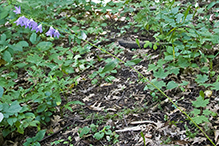 |
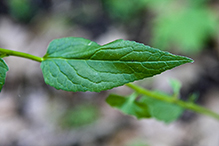 |
|
Plant |
Leaf |
|
 |
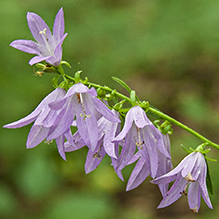 |
|
Inflorescence |
||
|
||
|
||
|
Inflorescence |

Slideshows |
Campanula rapunculoides |
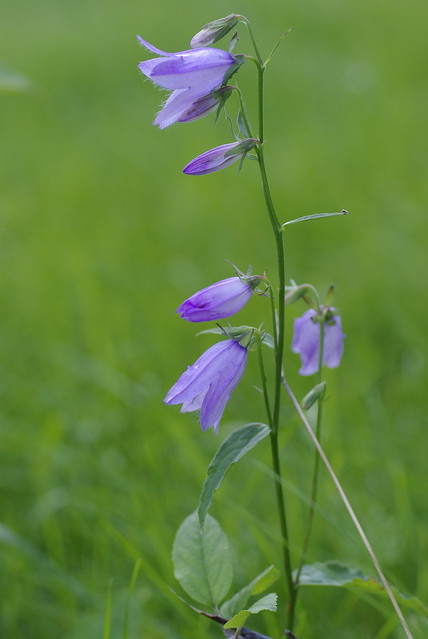
|
About
Ugressklokke, Creeping Bellflower |
Creeping Bellflower |
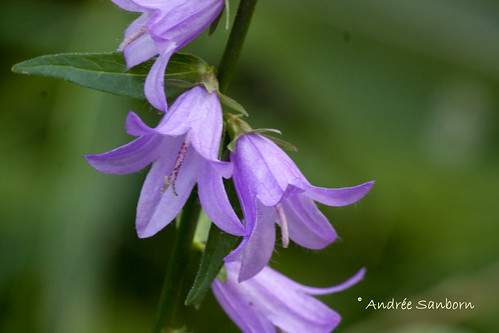
|
About
Campanula rapunculoides |

Visitor Videos |
||
Share your video of this plant. |
||
This button not working for you? |
||
|
Other Videos |
||
Creeping Bellflower, identification of the Wisconsin Invasive Species Campanula rapunculoides |
About
Uploaded on Jan 31, 2011 This is part of a series of videos providing key characteristics for the identification of invasive plants listed in Wisconsin's invasive species administrative rule NR 40. These videos are produced by Dr. Mark Renz of the University of Wisconsin-Madison. For more information on invasive plants and invasive plant management in Wisconsin visit http://ipcm.wisc.edu/Publications/WeedSciencepublications/tabid/116/Default.aspx |
Creeping Bellflower (Campanula Rapunculoides) - 2012-07-14 |
About
Published on Jul 16, 2012 Campanula rapunculoides, common names Creeping Bellflower or Rampion Bellflower, is a perennial herbaceous plant of the genus Campanula, belonging to the family Campanulaceae. -------------------- |

Created 12/27/2011 Last Updated: © MinnesotaSeasons.com. All rights reserved. |
